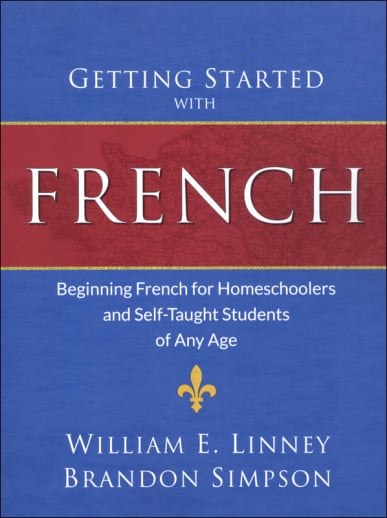With the goal of being self-explanatory, self-paced and self-contained, this course was written for the homeschooled student in mind. Free pronunciation recordings are available online in an mp3 format and an answer key is in the back of the book itself. Tests can be done by backing up to the previous lesson and having your student translate the exercises there. A parent can use the answer key to grade these, or have the student correct their own work. Students are encouraged to do 30 minutes a day rather than a longer session once or twice a week, but many of the lessons might take only15-20 minutes. This is a stripped down way to introduce your students to French. Each lesson is only a page long for the first 21 lessons and not much longer after that (1-3 pgs). You will cover basics of how to learn French such as pronunciation, gender, formal vs. informal language, some pronouns, beginner vocabulary, expressions which have a cultural element and other useful basics. While there is not enough content here for a full high school credit, after completing this book, your student would be ready for a first year high school level program having never had any other language instruction. This would also be a good option for an older elementary student or a middleschooler interested in French. Both Getting Started with French and Getting Started with Spanish are good ways for a student (and their parents) to see if they are really interested in the further study of a language. Helpful glossary in the back, 281 pp, sc, 8 x 11 ~ Sara
Getting Started with French
Description
These Getting Started With foreign language courses were written with the homeschooled student in mind. They are an efficient way to introduce your students to a foreign language. You will cover basics of how to learn a language such as pronunciation, gender, formal vs. informal language, some pronouns, beginner vocabulary, expressions which have a cultural element, and other useful basics. Courses offered include Spanish, French, German, Russian, Latin, and Ancient Greek.
While there is not enough content here for a full high school credit, after
completing this book, your student would be well-prepared for a high school level
foreign language program. Tests can be done by backing up to the previous
lesson and having your student translate the exercises there. A parent can use
the answer key to grade these, or have the student correct their own work.
These are a good option for upper elementary or middle-grade students (and
their parents) to see if they are really interested in the further study of a
language. Helpful glossaries are included.
| Product Format: | Paperback |
|---|---|
| Grades: | 4-AD |
| Brand: | Armfield Academic Press |
| ISBN: | 9781626110052 |
| Length in Inches: | 10.875 |
| Width in Inches: | 8.25 |
| Height in Inches: | 0.625 |
| Weight in Pounds: | 1.55 |

